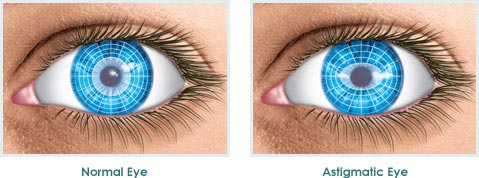Astigmatism is a common, mild and generally easily treatable imperfection in the curvature of your eye. The condition can cause blurred vision.
Astigmatism occurs when the front surface of your eye (cornea) or the lens, inside your eye, has a slightly different surface curvature in one direction from the other. Instead of being even and smooth in all directions, the surface may have some areas that are flatter or steeper.
Astigmatism blurs your vision at all distances. Astigmatism is often present at birth and may occur in combination with nearsightedness or farsightedness. Often it’s not pronounced enough to require corrective action. When it is, your treatment options include corrective lenses and surgery.
Your eye has two parts that focus images, the cornea and the lens. In a perfectly shaped eye, each of these focusing elements has a perfectly smooth curvature, like the surface of a smooth ball.
A cornea or lens with such a surface curvature bends (refracts) all incoming light the same way and makes a sharply focused image on the back of your eye (retina).
However, if your cornea or lens isn’t evenly and smoothly curved, then it causes light rays to be unevenly focused. This causes a refractive error. Astigmatism is a type of refractive error.
In astigmatism, your cornea or lens is curved more steeply in one direction than in another. You have corneal astigmatism if your cornea has a distorted shape. You have lenticular astigmatism if your lens is distorted.
Either type of astigmatism can cause blurred vision. Blurred vision may occur more in one direction, either horizontally, vertically or diagonally.
Astigmatism may occur in combination with other refractive errors, which include:
- Nearsightedness (myopia). This occurs when your cornea is curved too much or your eye is longer than normal. Instead of being focused precisely on your retina, light is focused in front of your retina, resulting in a blurry appearance for distant objects.
- Farsightedness (hyperopia). This occurs when your cornea is curved too little or your eye is shorter than normal. The effect is the opposite of nearsightedness. When your eye is in a relaxed state, light is focused behind the back of your eye, making nearby objects blurry.
(Source: mayoclinic)

